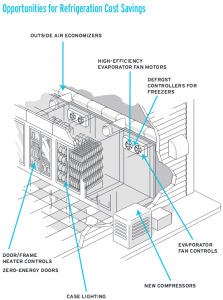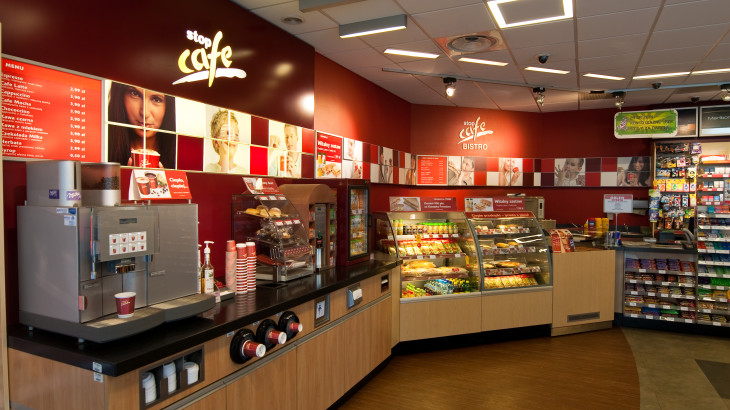Convenience stores can be small in size, but can consume a lot of energy in many different ways. As such, there are a number of ways to improve grocery and convenience store energy efficiency. From rooftop units that control heating and cooling, to walk-in coolers and freezers that keep our milk and favorite ice cream cold, or to interior and exterior lighting to keep products and storefronts well-lit, grocery and convenience stores can be complex energy consumers. The following will look at how convenience stores, from small corner markets to large 24-hour stores, can save money and energy.
Overhead and Exterior Lighting
For all businesses, lighting is important. For convenience stores, lighting plays a very important two-tiered role, both for drawing customers into your store and to your products and services.
Convenience stores usually have higher electricity bills from lighting expenses than many other small businesses. Most convenience stores are open 10-12 hours a day, and many are 24-hours. To reduce lighting energy costs, a few solutions are available:
- Upgrade to more energy efficient LED lighting. Newer, more efficient lighting technology can last up to 10 times longer and reduce energy costs by up to 30% or more. Longer lasting lamps also means less replacement and maintenance costs.
- Install occupancy sensors in storage rooms, small closets, break rooms, restrooms, and other low-occupancy areas. If a room is unoccupied, occupancy sensors will automatically turn off the lights. This helps cut costs and makes energy management much easier. Retrofitting costs for occupancy sensors can have a payback of as low as 6 months and can save up to 70% on your energy costs.
LED Cooler Lighting
LED cooler lights illuminate your refrigerated display cases that house beer, soda, sports drinks, frozen dinners, and other cold treats. LED cooler lights emit considerably less heat than florescent lighting, which will reduces your lighting bill and the load on your refrigeration compressors. The less work your refrigeration compressors work to keep your products cool, the more energy you save. On average, LED cooler lights produce a 45% return on investment compared to fluorescents.
Let’s not forget the most important benefit of LED cooler lighting: it draws much more attention to your products, meaning customers are more likely to make a purchase. Imagine you are the owner of a 24-hour gas & convenience store, and your customers are filling up at the pump. They glance inside your store and are drawn to your beer and energy drinks because your LED cooler lights are making your products much easier to see and much more visually appealing. That’s extra revenue in your pocket.

Refrigeration
In most grocery and convenience stores, refrigeration accounts for 40%-60% of your total energy costs. Beyond LEDs, are many other measures to help cut costs exist, including the following:
Electronically Commutated Motors (EC motors)
EC motors help to significantly reduce the power output of your refrigeration motors. In the simplest explanation, there are two types of motors AC (alternating current/induction) and DC (direct current). Most evaporators in your refrigeration unit have 1/20 or 1/15 horsepower (HP) induction motors running the fans. Induction is extremely inefficient compared to DC motors. EC motors provide the same HP as an induction motor, but at a fraction of the electrical draw. By simply replacing the motor, you can save approximately 65% on your energy costs.
EC Motor Controls
You can reduce your refrigeration energy consumption even further by adding controls to EC motors. Motor fans do not need to run at full speed 100% of the time, only when the thermostat calls for a cooling cycle. By monitoring the inlet and outlet temperature of the coolant, the fan speed can be ramped up or down depending on the need.
EC motors and controls are a relatively simple installation and can have paybacks less than one year.
Anti-Sweat Heater Controls
Anti-sweat heat strip devices are installed in walk-in cooler and freezers to prevent moisture and fog buildup on the glass and frames. Typically, these devices run non-stop year-round. This is unnecessary: they should only run when needed. Anti-sweat heater controls limit the amount of time that they run, saving energy and money.
Anti-sweat heater controls save money in two ways. First, they reduce the frequency in which the heater runs. Second, they reduce the amount of heat produced, which puts less strain on the condenser. Anti-sweat heater controls are a common and easy installation with up to 70% energy savings and average paybacks in a year or less.
Defrost Controls
Most refrigeration systems run on a timed defrost cycle, regardless of whether your evaporator coils need defrosting or not. Using sensors, defrost controls intelligently sense when evaporator coils need defrosting, and only then consume the energy necessary to perform that operation. Installing defrost controls can save up to 30% on your energy costs per evaporator fan.
Other Measures
Other measures to refrigeration energy savings include floating heat pressure controls, insulation, condenser size optimization, and proper maintenance. For more information, schedule a no-cost energy efficiency audit for your business to speak with a professional.
Heating and Cooling
Heating and cooling is the second largest expense for grocery and convenience stores. In most cases, your heating and cooling will be operated by a rooftop unit HVAC system. Your HVAC system heats, cools, and ventilates a building to improve airflow, air quality, and overall comfort for occupants. There are several ways to improve the efficiency of your rooftop unit, including the following:
HVAC Economizers
An HVAC economizer will sense the inside and outside air temperatures. If the temperature of the air outside the building is cool enough for air conditioning, the economizer will turn off the compressor and utilize the outside air. This process can reduce costs up to 30% annually with a typical payback of less than one year.
Variable Frequency Drives
Variable frequency drives (VFDs) are devices that optimize the speed of a motor. Motors used in pumps and fans will run at full capacity regardless of the operation—whether that operation needs full power or not. A VFD solves the issue of wasting energy by adjusting the speed of the motor. In some instances, a VFD can save 50% of the energy required to perform an operation. Other benefits of a VFD include:
- Reduced fan noise
- Reduced initial motor power for startup
- Reduced maintenance
- Power factor correction
Final Thoughts
For their size, convenience stores are some of the most energy-complex businesses. From lighting, heating and cooling, and refrigeration, there are a variety of ways to save energy. For more information regarding convenience store energy efficiency, we strongly encourage speaking with an energy services company (ESCO) about energy saving solutions.




